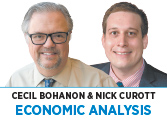Subscriber Benefit
As a subscriber you can listen to articles at work, in the car, or while you work out. Subscribe Now President Trump just awarded 78-year-old economist Arthur Laffer the Presidential Medal of Freedom. Some call the namesake of the so-called Laffer curve a kook and a fake; others see him as a hero. So who is right?
President Trump just awarded 78-year-old economist Arthur Laffer the Presidential Medal of Freedom. Some call the namesake of the so-called Laffer curve a kook and a fake; others see him as a hero. So who is right?
Laffer’s analysis is based on a simple premise: People respond to changes in price in a predictable way. Raise the price of something, folks buy less of it. Lower the price, they buy more of it. This insight is crucial to a clear-headed view of tax increases or decreases.
Let’s say that, at the local county fair, 500 cones of cotton candy are sold for $3 each. Now suppose the local fair board, in search of tax revenue, imposes a $1 per-cone tax on cotton candy. How much will the fair board collect? It’s probably not going to be $500. A dollar increase in the price of cotton candy will surely induce some fair-goers to substitute a different treat for cotton candy. If cotton candy sales drop to 300 cones, the tax revenue is $300.
Let’s now say the next year’s fair board doubles-down and raises the tax to $2. Suppose cotton-candy sales decline to 100 cones. Note the tax increase is counterproductive: Tax revenue actually declines from $300 to $200! What’s more, if the following year’s board lowers the tax back to $1, tax revenue from the cotton candy tax actually rises.
Now we agree with Laffer critics who assert that tax cuts rarely generate increased tax revenue. Nevertheless, the useful point of Laffer’s analysis is that the revenue forecast from a tax cut should incorporate the expected increase in the tax base. Correspondingly, the revenue forecast from a tax hike should incorporate the expected decrease in the tax base. This is not controversial and is important, especially in state and local policy formulation.
Philadelphia’s soda pop tax fell short of revenue forecasts by $13 million in 2017, as soda pop sales in the city fell 46%. New Jersey’s 2007 tax increase on cigarettes was expected to garner the state $30 million in additional state cigarette tax revenue but led to a reduction in cigarette tax revenue of $22 million.
While Laffer and his overzealous fans are wrong that tax cuts routinely increase tax revenue, Laffer’s critics should acknowledge that tax cuts increase the tax base. Love Laffer or hate him, but recognize his contribution.•
__________
Bohanon and Curott are professors of economics at Ball State University. Send comments to [email protected].
Please enable JavaScript to view this content.
